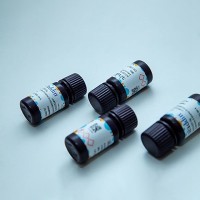Metabolic Labeling of Glycoproteins with Radioactive Sugars
互联网
- Abstract
- Table of Contents
- Materials
- Figures
- Literature Cited
Abstract
This unit describes methods for preparation of glycoproteins metabolically labeled with radioactive sugars, sulfate, and phosphate. Methods for liberation of both N? and O?linked glycans are also described. These protocols can be used to generate materials for characterization of glycoprotein glycans from cultured cells.
Table of Contents
- Basic Protocol 1: Pulse‐Chase Labeling with Radioactive Precursors
- Alternate Protocol 1: Long‐Term Labeling with Radioactive Precursor
- Support Protocol 1: Enzymatic Release of N‐Linked Glycans from Glycoproteins
- Support Protocol 2: Release of O‐Linked Glycans from Glycoproteins
- Reagents and Solutions
- Commentary
- Figures
- Tables
Materials
Basic Protocol 1: Pulse‐Chase Labeling with Radioactive Precursors
Materials
Alternate Protocol 1: Long‐Term Labeling with Radioactive Precursor
Support Protocol 1: Enzymatic Release of N‐Linked Glycans from Glycoproteins
Materials
Support Protocol 2: Release of O‐Linked Glycans from Glycoproteins
Materials
|
Figures
-
Figure 7.8.1 Pathways of sugar metabolism in mammalian cells. Compounds in boxes are precursors that can be taken up and incorporated into glycoconjugates. Pathways for conversion into the nucleotide sugar donors for biosynthesis are shown. Sugars in open boxes compete with Glc for uptake and incorporation. These are incorporated efficiently and can be used in the labeling procedures (see and ). Sugars in shaded boxes do not compete with Glc. They are incorporated less efficiently and should be used only in long‐term labeling experiments (see ). Abbreviations used: Fru, fructose; Fuc, fucose; Gal, galactose; GalNAc, N‐acetylgalactosamine; Glc, glucose; GlcA, glucuronic acid; GlcNAc, N‐acetylglucosamine; GlcNH2 , glucosamine; Man, mannose; ManNAc, N‐acetylmannosamine; NeuAc, N‐acetylneuraminic acid (a sialic acid); P, phosphate; UDP, uracil diphosphate; Xyl, xylose. View Image
Videos
Literature Cited
| Literature Cited | |
| Carlson, D.M. 1968. Structures and immunochemical properties of oligosaccharides isolated from pig submaxillary mucins. J. Biol. Chem. 243:616‐626. | |
| Chu, F.K. 1986. Requirements of cleavage of high mannose oligosaccharides in glycoproteins by peptide N‐glycosidase F. J. Biol. Chem. 261:172‐177. | |
| Diaz, S. and Varki, A. 1995. Metabolic radiolabeling of animal cell glycoconjugates. In Current Protocols in Protein Science (J.E. Coligan, B.M. Dunn, H.L. Ploegh, D.W. Speicher, and P. Wingfield, eds.) pp. 12.2.1‐12.2.15. John Wiley and Sons, New York. | |
| Elbein, A.D. 1987. Glycosylation inhibitors for N‐linked glycoproteins. Methods Enzymol 138:661‐709. | |
| Kingsley, D.M., Kozarsky, K.F., Hobbie, L., and Krieger, M. 1986. Reversible defects in O‐linked glycosylation and LDL receptor expression in a UPD‐Gal/UDP‐GalNAc 4‐epimerase deficient mutant. Cell 44:749‐759. | |
| Kornfeld, R. and Kornfeld, S. 1985. Assembly of asparagine‐linked oligosaccharides. Annu. Rev. Biochem. 54:631‐664. | |
| Lidholt, K. 1997. Biosynthesis of glycosaminoglycans in mammalian cells and in bacteria. Biochem. Soc. Trans. 25:866‐870. | |
| Perez‐Vilar, J. and Hill, R.L. 1999. The structure and assembly of secreted mucins. J. Biol. Chem. 274:31751‐31754. | |
| Rearick, J.I., Chapman, A., and Kornfeld, S. 1981. Glucose starvation alters lipid‐linked oligosaccharide biosynthesis in Chinese hamster ovary cells. J. Biol. Chem. 256:6255‐6261. | |
| Snider, M. D. and Rogers, O. C. 1986. Membrane traffic in animal cells: Cellular glycoproteins return to the site of Golgi mannosidase I. J. Cell Biol. 103:265‐275. | |
| Tarentino, A.L., Gomez, C.M., and Plummer, T.H. Jr. 1985. Deglycosylation of asparagine‐linked glycans by peptide:N‐glycosidase F. Biochemistry 24:4665‐4671. | |
| Key References | |
| Diaz and Varki, 1995. See above. | |
| Methods for glycoprotein labeling in cultured cells. | |
| Yurchenco, P.D., Ceccarini, C., and Atkinson, P.H. 1978. Labeling complex carbohydrates of animal cells with monosaccharides. Methods Enzymol. 50:175‐204. | |
| An excellent discussion of monosaccharide incorporation, with methods for determining the specific activity of incorporated label. |









